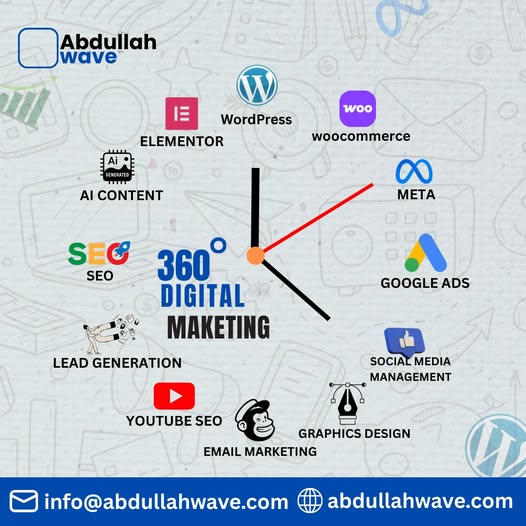Digital Marketing Explained: A Complete Guide for Beginners

In today’s connected world, people spend a lot of time on their phones, computers, and tablets. They search, shop, learn, and communicate online. This change in behavior has created a powerful way for businesses to reach customers: digital marketing.
This blog is a simple, beginner-friendly guide to understanding digital marketing and how you can use it to grow your business.
What Does Digital Marketing Mean?
Digital marketing is the process of promoting products or services using the internet and other digital channels. It includes websites, social media, search engines, emails, and mobile apps.
In simple words, digital marketing is any type of marketing that happens online.
Where Digital Marketing Happens:
On websites and blogs
In search engine results like Google
On platforms like Facebook, Instagram, and YouTube
Through emails
Inside apps or mobile notifications
Why is Digital Marketing So Important?
Here’s why digital marketing matters in today’s business world:
Most people are online every day
You can reach your ideal audience directly
It’s affordable compared to traditional advertising
You get instant data to measure performance
Even small businesses can compete with big brands
Online marketing lets you connect with your audience no matter where they are. It works 24/7 and helps you grow faster.
Common Types of Digital Marketing
Let’s look at some popular digital marketing strategies and how they work:
-
Search Engine Optimization (SEO)
SEO helps your website appear in search engines when people look for related products or services. The goal is to get free, organic traffic from Google or Bing.
Why it matters:
Increases website visibility
Attracts visitors without paid ads
Builds long-term credibility
-
Social Media Marketing
This involves using platforms like Facebook, Instagram, LinkedIn, TikTok, or Twitter to reach and engage your audience.
Benefits:
Boosts brand awareness
Helps you build trust with followers
Allows targeted advertising
-
Paid Ads or Pay-Per-Click (PPC)
With PPC, you run ads and only pay when someone clicks them. Google Ads and Facebook Ads are common examples.
Why use PPC:
Instant visibility
Great for promotions or new launches
You control how much you spend
-
Email Marketing
Sending marketing messages through email is still one of the most powerful tools. You can send newsletters, offers, and updates directly to your subscribers.
Advantages:
Very high return on investment
Keeps your audience informed and engaged
Easy to automate
-
Content Marketing
This is about creating helpful content like blog posts, videos, guides, or infographics to educate and attract your target audience.
Why content works:
Builds trust and authority
Helps with SEO
Encourages people to share your content
-
Affiliate Marketing
In this model, you let others promote your products. They earn a commission for every sale made through their unique referral link.
Benefits:
Expands your reach
Only pay for results
Great for passive income (if you’re the promoter)
How to Start Digital Marketing: A Step-by-Step Plan
Getting started is not hard. Here’s a simple path to follow:
Step 1: Define What You Want to Achieve
Your goals might include getting more website visitors, increasing product sales, or building your brand online.
Step 2: Understand Your Audience
Learn about your ideal customers—what they like, where they spend time online, and how they make decisions.
Step 3: Build a Website or Landing Page
Your website is your online home. It should be fast, mobile-friendly, and clearly explain what you offer.
Step 4: Work on SEO
Use relevant keywords, create helpful content, and make sure your site loads quickly. This helps you rank better in search engines.
Step 5: Start Posting on Social Media
Share updates, tips, and promotions. Respond to comments and connect with your audience. Be consistent.
Step 6: Run Targeted Ads
Start with a small budget. Test different ads and adjust based on performance.
Step 7: Track and Improve
Use free tools like Google Analytics or Meta Business Suite to monitor your results. Learn what works and do more of it.
Helpful Tools for Digital Marketing
Here are a few tools to make your marketing easier:
Tool Use
Google Analytics Tracks website traffic and behavior
Canva Creates social media posts and banners
Mailchimp Manages email marketing campaigns
Ubersuggest Helps with SEO and keyword ideas
Meta Ads Manager Runs Facebook and Instagram ads
Beginner Tips for Digital Marketing Success
Keep your message simple and clear
Post valuable content regularly
Focus on solving customer problems
Always test and tweak your strategies
Stay updated with new tools and trends
Final Thoughts
Digital marketing is not just a trend—it’s the future of business. Whether you are a freelancer, small shop owner, or part of a large company, online marketing can help you grow faster and smarter.
You don’t need to be an expert to start. With patience, practice, and the right tools, anyone can succeed in digital marketing.